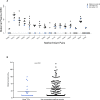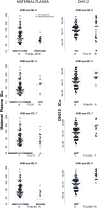Infant transmitted/founder HIV-1 viruses from peripartum transmission are neutralization resistant to paired maternal plasma
- PMID: 29672607
- PMCID: PMC5908066
- DOI: 10.1371/journal.ppat.1006944
Infant transmitted/founder HIV-1 viruses from peripartum transmission are neutralization resistant to paired maternal plasma
Abstract
Despite extensive genetic diversity of HIV-1 in chronic infection, a single or few maternal virus variants become the founders of an infant's infection. These transmitted/founder (T/F) variants are of particular interest, as a maternal or infant HIV vaccine should raise envelope (Env) specific IgG responses capable of blocking this group of viruses. However, the maternal or infant factors that contribute to selection of infant T/F viruses are not well understood. In this study, we amplified HIV-1 env genes by single genome amplification from 16 mother-infant transmitting pairs from the U.S. pre-antiretroviral era Women Infant Transmission Study (WITS). Infant T/F and representative maternal non-transmitted Env variants from plasma were identified and used to generate pseudoviruses for paired maternal plasma neutralization sensitivity analysis. Eighteen out of 21 (85%) infant T/F Env pseudoviruses were neutralization resistant to paired maternal plasma. Yet, all infant T/F viruses were neutralization sensitive to a panel of HIV-1 broadly neutralizing antibodies and variably sensitive to heterologous plasma neutralizing antibodies. Also, these infant T/F pseudoviruses were overall more neutralization resistant to paired maternal plasma in comparison to pseudoviruses from maternal non-transmitted variants (p = 0.012). Altogether, our findings suggest that autologous neutralization of circulating viruses by maternal plasma antibodies select for neutralization-resistant viruses that initiate peripartum transmission, raising the speculation that enhancement of this response at the end of pregnancy could further reduce infant HIV-1 infection risk.
Conflict of interest statement
The authors have declared that no competing interests exist.
Figures







Similar articles
-
Mutations that confer resistance to broadly-neutralizing antibodies define HIV-1 variants of transmitting mothers from that of non-transmitting mothers.PLoS Pathog. 2021 Apr 2;17(4):e1009478. doi: 10.1371/journal.ppat.1009478. eCollection 2021 Apr. PLoS Pathog. 2021. PMID: 33798244 Free PMC article.
-
Maternal Broadly Neutralizing Antibodies Can Select for Neutralization-Resistant, Infant-Transmitted/Founder HIV Variants.mBio. 2020 Mar 10;11(2):e00176-20. doi: 10.1128/mBio.00176-20. mBio. 2020. PMID: 32156815 Free PMC article.
-
Postnatally-transmitted HIV-1 Envelope variants have similar neutralization-sensitivity and function to that of nontransmitted breast milk variants.Retrovirology. 2013 Jan 10;10:3. doi: 10.1186/1742-4690-10-3. Retrovirology. 2013. PMID: 23305422 Free PMC article.
-
Antibodies for prevention of mother-to-child transmission of HIV-1.Curr Opin HIV AIDS. 2015 May;10(3):177-82. doi: 10.1097/COH.0000000000000150. Curr Opin HIV AIDS. 2015. PMID: 25700205 Free PMC article. Review.
-
The Role of Maternal HIV Envelope-Specific Antibodies and Mother-to-Child Transmission Risk.Front Immunol. 2017 Sep 4;8:1091. doi: 10.3389/fimmu.2017.01091. eCollection 2017. Front Immunol. 2017. PMID: 28928750 Free PMC article. Review.
Cited by
-
A Rare Mutation in an Infant-Derived HIV-1 Envelope Glycoprotein Alters Interprotomer Stability and Susceptibility to Broadly Neutralizing Antibodies Targeting the Trimer Apex.J Virol. 2020 Sep 15;94(19):e00814-20. doi: 10.1128/JVI.00814-20. Print 2020 Sep 15. J Virol. 2020. PMID: 32669335 Free PMC article.
-
Induction of Neutralizing Responses against Autologous Virus in Maternal HIV Vaccine Trials.mSphere. 2020 Jun 3;5(3):e00254-20. doi: 10.1128/mSphere.00254-20. mSphere. 2020. PMID: 32493720 Free PMC article. Clinical Trial.
-
Immunological mechanisms of inducing HIV immunity in infants.Vaccine. 2020 Jan 16;38(3):411-415. doi: 10.1016/j.vaccine.2019.11.011. Epub 2019 Nov 21. Vaccine. 2020. PMID: 31761501 Free PMC article. Review.
-
Pre-existing infant antibody-dependent cellular cytotoxicity associates with reduced HIV-1 acquisition and lower morbidity.Cell Rep Med. 2021 Oct 19;2(10):100412. doi: 10.1016/j.xcrm.2021.100412. eCollection 2021 Oct 19. Cell Rep Med. 2021. PMID: 34755132 Free PMC article.
-
Different evolutionary pathways of HIV-1 between fetus and mother perinatal transmission pairs indicate unique immune selection in fetuses.Cell Rep Med. 2021 Jun 16;2(7):100315. doi: 10.1016/j.xcrm.2021.100315. eCollection 2021 Jul 20. Cell Rep Med. 2021. PMID: 34337555 Free PMC article.
References
-
- UNAIDS. Progress Report on the Global Plan: towards the elimi- nation of new HIV infections among children and keeping their mothers alive UNAIDS, Geneva, Switzerland: 2015.
-
- Dorenbaum A, Cunningham CK, Gelber RD, Culnane M, Mofenson L, Britto P, et al. Two-dose intrapartum/newborn nevirapine and standard antiretroviral therapy to reduce perinatal HIV transmission: a randomized trial. JAMA. 2002;288(2):189–98. - PubMed
-
- Wolinsky SM, Wike CM, Korber BT, Hutto C, Parks WP, Rosenblum LL, et al. Selective transmission of human immunodeficiency virus type-1 variants from mothers to infants. Science. 1992;255(5048):1134–7. - PubMed
-
- Garcia PM, Kalish LA, Pitt J, Minkoff H, Quinn TC, Burchett SK, et al. Maternal levels of plasma human immunodeficiency virus type 1 RNA and the risk of perinatal transmission. Women and Infants Transmission Study Group. N Engl J Med. 1999;341(6):394–402. doi: 10.1056/NEJM199908053410602 - DOI - PubMed
Publication types
MeSH terms
Substances
Grants and funding
LinkOut - more resources
Full Text Sources
Other Literature Sources
Medical
Molecular Biology Databases
Miscellaneous

